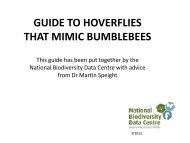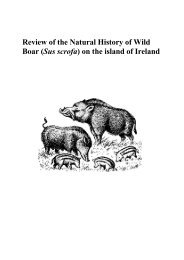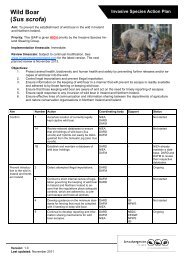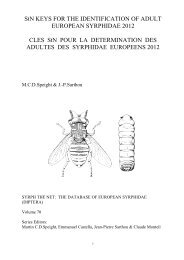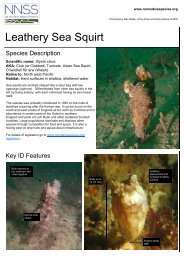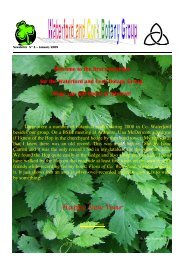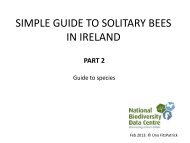StN DATABASE: CONTENT AND GLOSSARY OF ... - Pollinators
StN DATABASE: CONTENT AND GLOSSARY OF ... - Pollinators
StN DATABASE: CONTENT AND GLOSSARY OF ... - Pollinators
Create successful ePaper yourself
Turn your PDF publications into a flip-book with our unique Google optimized e-Paper software.
eech-fir-spruce forests on acid soils, with Luzula luzuloides, Polytrichum formosum , and often<br />
Deschampsia flexuosa, Vaccinium myrtillus, Pteridium aquilinum.<br />
CORINE 41.12: ATLANTIC ACIDOPHILOUS BEECH FORESTS, Ilici-Fagenion. Atlantic forests<br />
on acid soils, differing from 41.11 by the absence of Luzula luzuloides and a greater abundance of Ilex<br />
aquifolium.<br />
CORINE 41.13: NEUTROPHILOUS BEECH FORESTS, Asperulo-Fagenion. Medio-European and<br />
Atlantic forests, on neutral or near-neutral soils, with mull humus, characterised by a strong<br />
representation of species belonging to the ecological groups of Anemone nemorosa, of Lamium<br />
galeobdolon, of Galium odoratum and Melica uniflora and, in mountains, various Dentaria, forming a<br />
richer and more abundant herb layer than in 41.11 and 41.12.<br />
CORINE 41.15: SUBALPINE BEECH WOODS, Aceri-Fagenion. Woods usually composed of low,<br />
low-branching trees, with much Acer pseudoplatanus, situated near the tree limit, mostly in low<br />
mountains with oceanic climate (Vosges, Schwarzwald, Rhön, Jura, outer Alps, Massif Central,<br />
Pyrenees). The herb layer is similar to that of 41.13 or locally 41.11 and with elements of adjacent<br />
open grasslands.<br />
humid (general), lowland unimproved grassland. Humid, lowland unimproved grasslands not normally<br />
subject to flooding (though temporary pools may be present at times of high rainfall and temporary<br />
seepages and streams can occur during periods of high groundwater levels). This category overlaps<br />
with the alluvial, lowland, unimproved grassland category and shares with it several (CORINE 37.21,<br />
22, 24) grassland types.<br />
humid/mesophilous (gen.), deciduous forests: acidophilous/mesophilous beech forests (Eu-Fagion -<br />
CORINE 41.1) including Central European acidophilous beech forest with woodrush (Luzulo-<br />
Fagenion - CORINE 41.11); humid types of oak-hornbeam forests (Carpinion betuli - CORINE 41.2)<br />
and in particular ash forest dominated by Fraxinus excelsior (CORINE 41.3) and humid/ mesophilous<br />
acidophilous oak forest (Quercus robori-petraeae - CORINE 41.5), all with stands of overmature,<br />
mature and young (saplings/scrub) trees.<br />
CORINE 41.1: BEECH FORESTS; forests dominated by Fagus sylvatica or, in Greece, F.orientalis or<br />
F.moesica. Many montane formations are beech-fir or beech-fir-spruce forests, to be noted as 43<br />
(mixed forests), but with the suffixes below; they are discussed with the corresponding deciduous<br />
forests.<br />
CORINE 41.11: CENTRAL EUROPEAN ACIDOPHILOUS BEECH FORESTS WITH WOODRUSH<br />
LUZULO-FAGENION, Medio-European beech and, in higher mountains, beech-fir or beech-fir-spruce<br />
forests on acid soils, with Luzula luzuloides, Polytrichum formosum, and often Deschampsia flexuosa,<br />
Vaccinium myrtillus, Pteridium aquilinum.<br />
CORINE 41.2: OAK-HORNBEAM FORESTS; Carpinion betuli; Atlantic and medio-European forests<br />
dominated by Quercus robur or Q.petraea, on eutrophic or mesotrophic soils, with usually ample and<br />
species-rich herb and bush layers. Carpinus betulus is generally present. They occur under climates too<br />
dry or on soils too wet or too dry for beech or as a result of forestry practices favouring oaks.<br />
CORINE 41.3: ASH FORESTS; Carpinion betuli (Fraxino-Carpinion): Corylo-Fraxinetum p.,<br />
Polysticho setiferi-Fraxinetum excelsioris p., Mercurialidi perennis-Fraxinetum excelsioris p., Isopyro-<br />
Quercetum roboris, Adoxo-Aceretum; non-alluvial Atlantic or sub-Atlantic forests dominated by<br />
Fraxinus excelsior, particulary characteristic of Britain, of the north-western Iberian peninsula and of<br />
the Baltic moraine hills of Mecklenburg. Secondary formations pioneering on abandoned cultivated<br />
land (e.g. Belgian Condroz) are included.<br />
CORINE 41.5: ACIDOPHILOUS OAK FORESTS; Quercion robori-petraeae ; Forests of Quercus<br />
robur or Q. petraea on acid soils with a herb layer mostly constituted by the ecological groups of<br />
Deschampsia flexuosa, Vaccinium myrtillus, Pteridium aquilinum, Lonicera periclymenum, Holcus<br />
mollis, and of Maianthemum bifolium, Convallaria majalis, Hieracium sabaudum, Hypericum<br />
pulchrum, Luzula pilosa, and the mosses Polytrichum formosum and Leucobryum glaucum.<br />
humid Pinus sylvestris (gen.), coniferous forests: wet coniferous forests dominated by Pinus<br />
sylvestris, with stands of overmature, mature and young (saplings/scrub) trees: CORINE 42.51 and<br />
boreal Pinus forest.<br />
CORINE 42.51: CALEDONIAN FOREST; relict, indigenous Scots pine forests of endemic Pinus<br />
sylvestris var. scotica, limited to the central and north-eastern Grampians of Scotland. They are mostly<br />
open and have a ground layer usually rich in ericaceous species and mosses, in particular, Hylocomium<br />
splendens, and often arbouring, together with abundant Deschampsia flexuosa, Goodyera repens,<br />
Listera cordata, Corallorhiza trifida, Linneae borealis, Trientalis europeae, Pyrola minor, Moneses<br />
26



